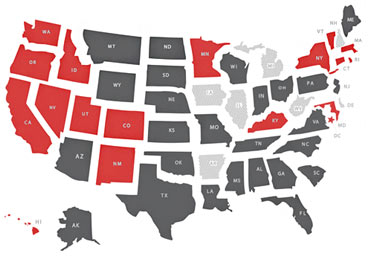Health Insurance Exchanges
Creation and Structure of Health Insurance Exchanges
The Affordable Care act will require the creation of Health Insurance Exchanges through which individuals and small businesses with up to 100 employees can purchase qualified coverage. States are permitted to allow businesses with more than 100 employees to purchase coverage in the SHOP Exchange beginning in 2017.
States may form regional Exchanges or allow more than one Exchange to operate in a state as long as each Exchange serves a distinct geographic area. (Funding is available to states to establish Exchanges within one year of enactment and until January 1, 2015)

Eligibility to Purchase in the Exchanges
Restrict access to coverage through the Exchanges to U.S. citizens and legal immigrants who are notincarcerated.
Effective Dates
Unless otherwise noted, provisions relating to the American Health Benefit Exchages are effective January 1, 2014.Requirements of the Exchanges
- Exchanges are required to maintain a call center for customer service, and establish procedures for
enrolling individuals and businesses and for determining eligibility for tax credits. States are required to develop a single form for applying for state health subsidy programs that can be filed online, in person,
by mail or by phone. Exchanges are permitted to contract with state Medicaid agencies to determine eligibility
for tax credits in the Exchanges.
- Exchanges are required to submit financial reports to the Secretary and comply with oversight investigations including a GAO study on the operation and administration of Exchanges.
Qualifications of Participating Health Plans
- Qualified health plans participating in the Exchange must meet marketing requirements, have
adequate provider networks, contract with essential community providers, contract with navigators
to conduct outreach and enrollment assistance, be accredited with respect to performance on quality
measures, use a uniform enrollment form and use standard format to present plan information.
- Qualified health plans must report information on claims payment policies, enrollment,
disenrollment, number of claims denied, cost-sharing requirements, out-of-network policies, and
enrollee rights in plain language.
Insurance Market and Rating Rules
Guaranteed issue and renewability is required and rating variation is allowed based only on age (limited to 3 to 1 ratio), premium rating area, family composition, and tobacco use (limited to 1.5 to 1 ratio) in the individual and small group market and the Exchange.
- Risk adjustment is required in the individual and small group markets and in the Exchange. (Effective January 1, 2014)
Basic Health Plan
States are permitted the option to create a Basic Health Plan for uninsured individuals with incomes between 133-200% Federal Poverty Level (FPL) who would otherwise be eligible to receive premium subsidies in the Exchange. States opting to provide this coverage will contract with one or more standard plans to provide at least the essential health benefits and must ensure that eligible individuals do not pay more in premiums than they would have paid in the Exchange and that the cost-sharing requirements do not exceed those of the platinum plan for enrollees with income less than 150% FPL or the gold plan for all other enrollees. States will receive 95% of the funds that would have been paid as federal premium and cost-sharing subsidies for eligible individuals to establish the Basic Health Plan. Individuals with incomes between 133-200% FPL in states creating Basic Health Plans will not be eligible for subsidies in the ExchangesBenefit Tiers
- Four benefit categories of plans are allowed plus a separate catastrophic plan to be offered through the
Exchange, and in the individual and small group markets:
- Bronze plan represents minimum creditable coverage and provides the essential health benefits, covers 60% of the benefit costs of the plan, with an out-of-pocket limit equal to the Health Savings Account (HSA) current law limit ($5,950 for individuals and $11,900 for families in 2010);
- Silver plan provides the essential health benefits, covers 70% of the benefit costs of the plan, with the
HSA out-of-pocket limits;
- Gold plan provides the essential health benefits, covers 80% of the benefit costs of the plan, with the
HSA out-of-pocket limits;
- Platinum plan provides the essential health benefits, covers 90% of the benefit costs of the plan, with
the HSA out-of-pocket limits;
- Catastrophic plan available to those up to age 30 or to those who are exempt from the mandate to
purchase coverage and provides catastrophic coverage only with the coverage level set at the HSA
current law levels except that prevention benefits and coverage for three primary care visits would be
exempt from the deductible. This plan is only available in the individual market.
- Bronze plan represents minimum creditable coverage and provides the essential health benefits, covers 60% of the benefit costs of the plan, with an out-of-pocket limit equal to the Health Savings Account (HSA) current law limit ($5,950 for individuals and $11,900 for families in 2010);
- Reduce the out-of-pocket limits for those with incomes up to 400% FPL to the following levels:
- – 100-200% FPL: one-third of the HSA limits ($1,983/individual and $3,967/family);
- – 200-300% FPL: one-half of the HSA limits ($2,975/individual and $5,950/family);
- – 300-400% FPL: two-thirds of the HSA limits ($3,987/individual and $7,973/family).
- These out-of-pocket reductions are applied within the actuarial limits of the plan and will not increase the actuarial value of the plan.
- – 100-200% FPL: one-third of the HSA limits ($1,983/individual and $3,967/family);
Consumer Operated and Oriented Plan (CO-OP)
Consumer Operated and Oriented Plan (CO-OP) program was created to foster the creation of non-profit, member-run health insurance companies in all 50 states and District of Columbia to offer qualified health plans. To be eligible to receive funds, an organization must not be an existing health insurer or sponsored by a state or local government. Substantially all of the CO-OP's activities must consist of the issuance of qualified health benefit plans in each state in which it is licensed, governance of the organization must be subject to a majority vote of its members, must operate with a strong consumer focus, and any profits must be used to lower premiums, improve benefits, or improve the quality of health care delivered to its members. (Appropriate $4.8 billion to finance the program and award loans and grants to establish CO-OPs by July 1, 2013)Multi-State Plans
The Office of Personnel Management is required to contract with insurers to offer at least two multi-stateplans in each Exchange. At least one plan must be offered by a non-profit entity and at least one plan must not provide coverage for abortions beyond those permitted by federal law. Each multi-state plan must be licensed in each state and must meet the qualifications of a qualified health plan. If a state has lower age rating requirements than 3:1, the state may require multi-state plans to meet the more protective age rating rules. These multi-state plans will be offered separately from the Federal Employees Health Benefit Program and will have a separate risk pool.
Abortion Coverage
- States are permitted to prohibit plans participating in the Exchanges from providing coverage for abortions.
- Plans that choose to offer coverage for abortions beyond those for which federal funds are
permitted (to save the life of the woman and in cases of rape or incest) in states that allow such
coverage to create allocation accounts for segregating premium payments for coverage of abortion
services from premium payments for coverage for all other services to ensure that no federal premium
or cost-sharing subsidies are used to pay for the abortion coverage. Plans must also estimate the
actuarial value of covering abortions by taking into account the cost of the abortion benefit (valued at no less than $1 per enrollee per month) and cannot take into account any savings that might be reaped as
a result of the abortions. Plans participating in the Exchanges are prohibitedfrom discriminating against any provider because of an unwillingness to provide, pay for, provide coverage of, or refer for abortions.

Need Help?
Chat with a specialist with our:OR
Call us at: 1.800.693.3420